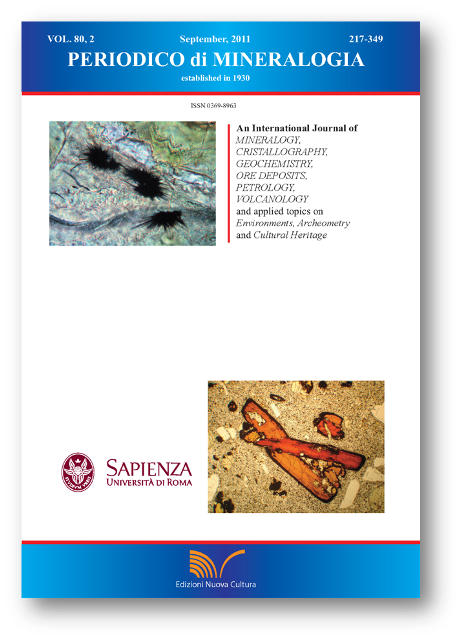Vein mineral assemblage in partially serpentinized peridotite xenolithsfrom Hyblean Plateau (south-eastern Sicily, Italy)
DOI:
https://doi.org/10.2451/2011PM0019Keywords:
serpentinization, hydrothermal system, sulphides, Hyblean Plateau, xenoliths.Abstract
Periodico di Mineralogia (2011), 80, 2, 247-266 - DOI:10.2451/2011PM0019
Vein mineral assemblage in partially serpentinized peridotite xenoliths
from Hyblean Plateau (south-eastern Sicily, Italy)
Fabio C. Manuella
Dipartimento di Scienze Geologiche, Università di Catania, C.so Italia 57, I-95129 Catania - Italy
fmanuella@alice.it
Abstract
A mineralogical study was performed on seven selected peridotite xenoliths, found in diatremic tuff-breccia deposits from Valle Guffari (Hyblean Plateau, Sicily, Italy), in order to investigate evidence for serpentinization. Petrographic examinations of spinel-harzburgites revealed the presence of the pervasive network of composite serpentine veins, suggesting a variable degree of alteration of 50-80%.
Veins were characterized by X-ray Powder Diffraction (XRPD), which allowed the identification of chrysotile 2Mc1 and lizardite 1T. No peaks referable to antigorite polymorphs were detected. Microprobe WDS (wavelength dispersion system) data evidenced a different iron content between chrysotile [average composition (Mg2.58Fe2+ 0.27Al0.01)Σ2.86Si2.06O5(OH)4, Fe/(Fe+Mg) = 0.09] and lizardite [average composition (Mg2.49Fe2+ 0.37Al0.01)Σ2.87 Si2.05O5(OH)4, Fe/(Fe+Mg) = 0.12]. Chlorine was detected in both polytypes, with an average concentration of 0.09 wt% in chrysotile and 0.05 wt% in lizardite.
A series of cogenetic secondary minerals are enclosed in serpentine veins, described hereunder:
a) Sulphides, predominantly S-poor phases (atomic sulphur/metal ratio < 1), which are heazlewoodite [average composition (Ni2.75Fe0.09)Σ2.84S2] and godlevskite [mean composition (Ni8.52Fe0.63)Σ9.15S8), and to a lesser extent by S-rich sulphides (S/M > 1), such as millerite [mean composition (Ni0.95Fe0.03)Σ0.98S] and polydymite-violarite solid solution [mean composition (Fe1.38Ni1.69)Σ3.07S4].
b) Interstitial dendritic aggregates of Na-rich sylvite, whose molar ratio of NaCl/(NaCl+KCl) (XNaCl) varies from 0.03 to 0.21.
c) Widespread veinlets of (Ca, Na, S)-rich phosphates (CaO 50.30-52.70 wt%, Na2O 1.50-3.10 wt%, P2O5 31.76-34.60 wt%, SO3 7.40-12.60 wt%), whose chemical composition is similar to (Na, S)-rich apatite-(CaOH)-M (CaO 48.70-54.30 wt%, Na2O 0.10-3.90 wt%, P2O5 32.01-40.82 wt%, SO3 0.40-11.40 wt%).
d) Aragonite veins.
e) Fe-rich saponit.
f) Chalcedony.
The studied secondary mineral assemblage hints that serpentinization...


